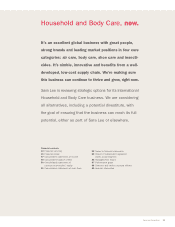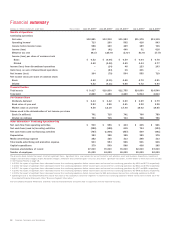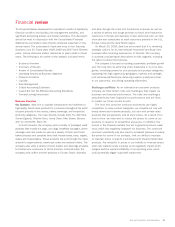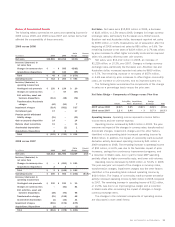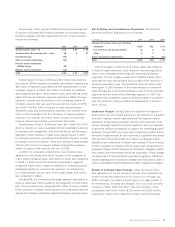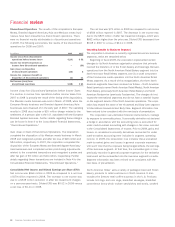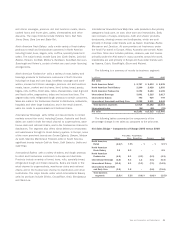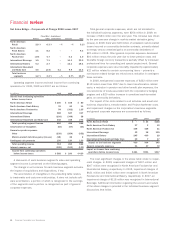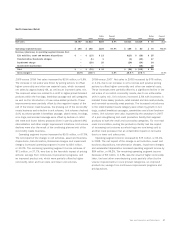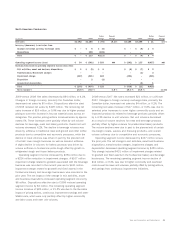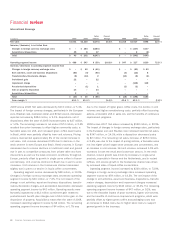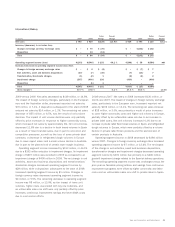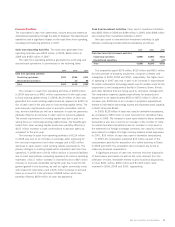Sara Lee 2009 Annual Report Download - page 25
Download and view the complete annual report
Please find page 25 of the 2009 Sara Lee annual report below. You can navigate through the pages in the report by either clicking on the pages listed below, or by using the keyword search tool below to find specific information within the annual report.•Finalization of Tax Reviews and Audits –A $96 million benefit in
2008 resulted from the resolution of tax audits and the expiration
of statutes of limitations in France, Morocco, the Netherlands, the
Philippines and various state and local jurisdictions. Of this amount,
$40 million related to the resolution of tax audits and $56 million
related to the expiration of statutes of limitations. In 2007, the
corporation realized a $110 million tax benefit upon reducing its
tax contingency reserves related to uncertain tax positions.
•Receipt of Contingent Sales Proceeds – The corporation recognized
a tax benefit of $46 million related to its receipt of non-taxable
contingent sales proceeds pursuant to the sale terms of its European
cut tobacco business in 1999, compared to a $42 million tax benefit
in 2007.
•Valuation Allowance – A $19 million benefit relates to the net
reversal of valuation allowances, primarily on German deferred tax
assets, compared to a $27 million tax charge in 2007. During
2008, the corporation determined that a valuation allowance was
no longer necessary for certain German deferred tax assets as a
result of revised profitability projections for its German operations.
This benefit was partially offset by the establishment of valuation
allowances for certain state deferred tax assets in which the
corporation does not anticipate future realization. The corporation
determined that a valuation allowance was necessary for deferred
tax assets in certain state jurisdictions as a result of revised
projections indicating insufficient taxable income of the appropriate
character within the carryback and carryforward periods available
under the respective tax statutes.
•Foreign Earnings – The corporation’s global mix of earnings, the
tax characteristics of the corporation’s income, and the benefit from
certain foreign jurisdictions that have lower tax rates also reduced
the corporation’s tax expense during 2008, similar to 2007.
•Sale of Capital Assets – In 2007, the corporation sold shares of
a subsidiary resulting in a $169 million tax benefit. No comparable
transaction occurred in 2008.
Income (Loss) from Continuing Operations and Diluted Earnings per
Share (EPS) from Continuing Operations Income from continuing
operations in 2009 was $364 million, which was $405 million
higher than 2008. The loss from continuing operations in 2008 was
$41 million, which was $481 million lower than the $440 million
of income reported in 2007.
Diluted EPS from continuing operations was income of $0.52
in 2009 versus a loss of $0.06 in 2008 and income of $0.59 in
2007. The diluted EPS from continuing operations in each succeeding
year was favorably impacted by lower average shares outstanding
as the corporation has been repurchasing shares of its common stock
as part of an ongoing share repurchase program. The corporation
repurchased 11 million shares, 20 million shares and 42 million shares
of common stock during 2009, 2008 and 2007, respectively.
Sara Lee Corporation and Subsidiaries 23
•Valuation Allowance – The corporation recognized tax expense
of $5 million related to a net increase in valuation allowances,
primarily on current year Russian net operating losses, compared to
a $19 million tax benefit in 2008. The 2009 tax charge was partially
offset by the utilization of Brazilian net operating losses that the
corporation did not previously anticipate would be realized. The
corporation expects that its effective tax rate could be favorably or
unfavorably impacted in future fiscal years as a result of changes
in facts and circumstances that cause the corporation to revise its
conclusions on the ability to realize certain net operating losses and
other deferred tax attributes. However, because of the inherent
uncertainty with respect to the occurrence of such facts and circum-
stances, management is not able to predict potential outcomes
or the related impact on the corporation’s effective tax rate.
•Foreign Earnings – The corporation’s global mix of earnings, the
tax characteristics of the corporation’s income, and the benefit from
certain foreign jurisdictions that have lower tax rates also reduced
the corporation’s tax expense during 2009, similar to 2008. As
specifically highlighted in Part I. Item 1A. Risk Factors, of the corpo-
ration’s Form 10-K, the corporation expects that its effective tax
rate will be impacted in future fiscal years as a result of its global
mix of earnings. Because the impact of the corporation’s global mix
of earnings is dependent on factors such as tax legislation in the
jurisdictions in which the corporation does business, the corporation’s
actual results, the relative mix of earnings amongst its respective
jurisdictions in any respective period, and tax characteristics of the
corporation’s income, acquisitions and dispositions, among other
factors, management is not able to predict the impact or trend that
the global mix of earnings will have on its effective tax rate.
2008 vs. 2007
In 2008, the corporation recognized tax expense
on continuing operations of $201 million, or an effective tax rate
of 125.6%, compared to a tax benefit of $11 million in 2007, or an
effective tax rate of (2.6%). The significant components impacting
the corporation’s 2008 effective tax rate are as follows:
•Goodwill Impairment – The corporation’s 2008 effective tax
rate increased by 173.5% as a result of recognizing $790 million
of non-deductible goodwill impairments, compared to $95 million
of non-deductible goodwill impairments in 2007.
•Remittance of Foreign Earnings – The corporation incurred a tax
charge of $118 million related to the repatriation of earnings from
certain foreign subsidiaries, compared to a $194 million tax charge
in 2007. The 2008 charge increased the effective rate by 74.0%.


